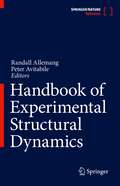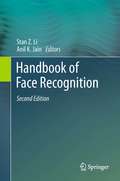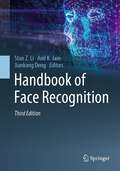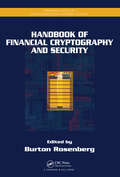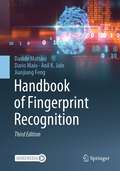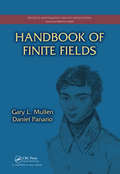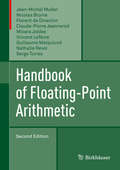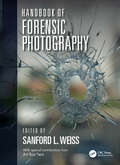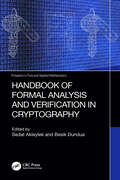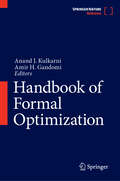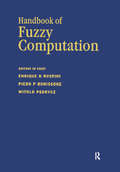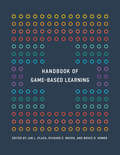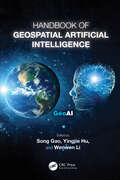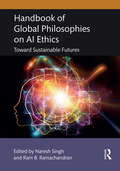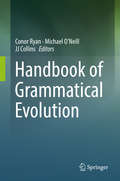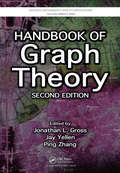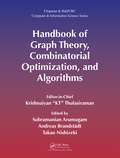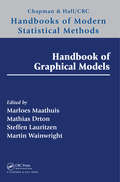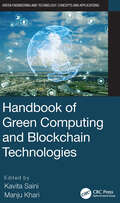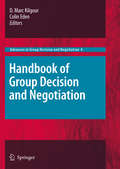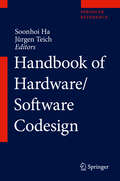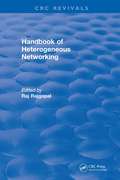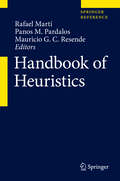- Table View
- List View
Handbook of Experimental Structural Dynamics
by Randall Allemang Peter AvitabileThe SEM Handbook of Experimental Structural Dynamics stands as a comprehensive overview and reference for its subject, applicable to workers in research, product design and manufacture, and practice. The Handbook is devoted primarily to the areas of structural mechanics served by the Society for Experimental Mechanics IMAC community, such as modal analysis, rotating machinery, structural health monitoring, shock and vibration, sensors and instrumentation, aeroelasticity, ground testing, finite element techniques, model updating, sensitivity analysis, verification and validation, experimental dynamics sub-structuring, quantification of margin and uncertainty, and testing of civil infrastructure. Chapters offer comprehensive, detailed coverage of decades of scientific and technologic advance and all demonstrate an experimental perspective. Several sections specifically discuss the various types of experimental testing and common practices utilized in the automotive, aerospace, and civil structures industries. · History of Experimental Structural Mechanics · DIC Methods - Dynamic Photogrammetry · LDV Methods · Applied Digital Signal Processing · Introduction to Spectral - Basic Measurements · Structural Measurements - FRF · Random and Shock Testing · Rotating System Analysis Methods · Sensors Signal Conditioning Instrumentation · Design of Modal Tests · Experimental Modal Methods · Experimental Modal Parameter Evaluation · Operating Modal Analysis Methods · Analytical Numerical Substructuring · Finite Element Model Correlation · Model Updating · Damping of Materials and Structures · Model Calibration and Validation in Structures · Uncertainty Quantification: UQ, QMU and Statistics · Nonlinear System Analysis Methods (Experimental) · Structural Health Monitoring and Damage Detection · Experimental Substructure Modeling · Modal Modeling · Response (Impedance) Modeling · Nonlinear Normal Mode Analysis Techniques (Analytical) · Modal Modeling with Nonlinear Connection Elements (Analytical) · Acoustics of Structural Systems (VibroAcoustics) · Automotive Structural Testing · Civil Structural Testing · Aerospace Perspective for Modeling and Validation · Sports Equipment Testing · Applied Math for Exper
Handbook of Face Recognition
by Stan Z. Li Anil K. JainThis highly anticipated new edition provides a comprehensive account of face recognition research and technology, spanning the full range of topics needed for designing operational face recognition systems. After a thorough introductory chapter, each of the following chapters focus on a specific topic, reviewing background information, up-to-date techniques, and recent results, as well as offering challenges and future directions. Features: fully updated, revised and expanded, covering the entire spectrum of concepts, methods, and algorithms for automated face detection and recognition systems; provides comprehensive coverage of face detection, tracking, alignment, feature extraction, and recognition technologies, and issues in evaluation, systems, security, and applications; contains numerous step-by-step algorithms; describes a broad range of applications; presents contributions from an international selection of experts; integrates numerous supporting graphs, tables, charts, and performance data.
Handbook of Face Recognition
by Stan Z. Li Anil K. Jain Jiankang DengThe history of computer-aided face recognition dates to the 1960s, yet the problem of automatic face recognition – a task that humans perform routinely and effortlessly in our daily lives – still poses great challenges, especially in unconstrained conditions.This highly anticipated new edition provides a comprehensive account of face recognition research and technology, spanning the full range of topics needed for designing operational recognition systems. After a thorough introduction, each subsequent chapter focuses on a specific topic, reviewing background information, up-to-date techniques, and recent results, as well as offering challenges and future directions.Topics and features:Fully updated, revised, and expanded, covering the entire spectrum of concepts, methods, and algorithms for automated detection and recognition systemsProvides comprehensive coverage of face detection, alignment, feature extraction, and recognition technologies, and issues in evaluation, systems, security, and applicationsContains numerous step-by-step algorithmsDescribes a broad range of applications from person verification, surveillance, and security, to entertainmentPresents contributions from an international selection of preeminent expertsIntegrates numerous supporting graphs, tables, charts, and performance dataThis practical and authoritative reference is an essential resource for researchers, professionals and students involved in image processing, computer vision, biometrics, security, Internet, mobile devices, human-computer interface, E-services, computer graphics and animation, and the computer game industry.
Handbook of Financial Cryptography and Security (Chapman & Hall/CRC Cryptography and Network Security Series)
by Burton RosenbergThe Handbook of Financial Cryptography and Security elucidates the theory and techniques of cryptography and illustrates how to establish and maintain security under the framework of financial cryptography. It applies various cryptographic techniques to auctions, electronic voting, micropayment systems, digital rights, financial portfolios, routing
Handbook of Fingerprint Recognition
by Anil K. Jain Jianjiang Feng Davide Maltoni Dario MaioA major new professional reference work on fingerprint security systems and technology from leading international researchers in the field. Handbook provides authoritative and comprehensive coverage of all major topics, concepts, and methods for fingerprint security systems. This unique reference work is an absolutely essential resource for all biometric security professionals, researchers, and systems administrators.
Handbook of Finite Fields (Discrete Mathematics and Its Applications)
by Gary L. Mullen Daniel PanarioPoised to become the leading reference in the field, the Handbook of Finite Fields is exclusively devoted to the theory and applications of finite fields. More than 80 international contributors compile state-of-the-art research in this definitive handbook. Edited by two renowned researchers, the book uses a uniform style and format throughout and
Handbook of Finite State Based Models and Applications (Discrete Mathematics and Its Applications)
by Jiacun WangApplicable to any problem that requires a finite number of solutions, finite state-based models (also called finite state machines or finite state automata) have found wide use in various areas of computer science and engineering. Handbook of Finite State Based Models and Applications provides a complete collection of introductory materials on fini
Handbook of Floating-Point Arithmetic
by Jean-Michel Muller Nicolas Brunie Florent De Dinechin Claude-Pierre Jeannerod Mioara Joldes Vincent Lefèvre Guillaume Melquiond Nathalie Revol Serge TorresFloating-point arithmetic is the most widely used way of implementing real-number arithmetic on modern computers. However, making such an arithmetic reliable and portable, yet fast, is a very difficult task. As a result, floating-point arithmetic is far from being exploited to its full potential. This handbook aims to provide a complete overview of modern floating-point arithmetic. So that the techniques presented can be put directly into practice in actual coding or design, they are illustrated, whenever possible, by a corresponding program. The handbook is designed for programmers of numerical applications, compiler designers, programmers of floating-point algorithms, designers of arithmetic operators, and more generally, students and researchers in numerical analysis who wish to better understand a tool used in their daily work and research.
Handbook of Forensic Photography
by Sanford L WeissHandbook of Forensic Photography is the most-comprehensive, definitive reference for the use of photography in the capture and presentation of forensic evidence. The intent is to inform the reader about the most complete and up-to-date methods to capture and reproduce images that most accurately represent the evidence. With the rise in importance of forensic science, crime and accident scene documentation has likewise increased in importance—not the least of which has been forensic photography. The need to use accepted practice and protocols to guarantee the authenticity of images for evidence documentation is paramount for using it in court. And as with any discipline, there is an art to the science of forensic photography. Contributing authors from various backgrounds—each experts in their field—have provided numerous case examples, best practices, and recommendations for recognizing, recording, and preserving evidence using cameras and the latest digital image technology, including video and other imaging technologies. Chapters present such topics as videography, drone photography, underwater photography, crime scene photography, autopsy photographs, fire documentation, forensic odontology, and more. The book closes with coverage of courtroom displays, presenting imaging evidence and expert witness testimony in the courtroom. Handbook of Forensic Photography is a must-have reference for experienced crime scene photographers, death and crime scene investigators, police, and forensic professionals—including medical examiners, odontologists, engineers, and forensic anthropologists—who frequently need to capture investigative photographs in the course of investigations.
Handbook of Formal Analysis and Verification in Cryptography (Prospects in Pure and Applied Mathematics)
by Sedat Akleylek Besik DunduaThis handbook of formal analysis in cryptography is very important for secure communication and processing of information. It introduces readers to several formal verification methods and software used to analyse cryptographic protocols. The chapters give readers general knowledge and formal methods focusing on cryptographic protocols. Handbook of Formal Analysis and Verification in Cryptography includes major formalisms and tools used for formal verification of cryptography, with a spotlight on new-generation cryptosystems such as post-quantum, and presents a connection between formal analysis and cryptographic schemes. The text offers formal methods to show whether security assumptions are valid and compares the most prominent formalism and tools as they outline common challenges and future research directions. Graduate students, researchers, and engineers worldwide will find this an exciting read.
Handbook of Formal Optimization
by Amir H. Gandomi Anand J. KulkarniThe formal optimization handbook is a comprehensive guide that covers a wide range of subjects. It includes a literature review, a mathematical formulation of optimization methods, flowcharts and pseudocodes, illustrations, problems and applications, results and critical discussions, and much more. The book covers a vast array of formal optimization fields, including mathematical and Bayesian optimization, neural networks and deep learning, genetic algorithms and their applications, hybrid optimization methods, combinatorial optimization, constraint handling in optimization methods, and swarm-based optimization. This handbook is an excellent reference for experts and non-specialists alike, as it provides stimulating material. The book also covers research trends, challenges, and prospective topics, making it a valuable resource for those looking to expand their knowledge in this field.
Handbook of Fuzzy Computation
by Enrique H Ruspini; Piero P Bonissone; Witold PedryczInitially conceived as a methodology for the representation and manipulation of imprecise and vague information, fuzzy computation has found wide use in problems that fall well beyond its originally intended scope of application. Many scientists and engineers now use the paradigms of fuzzy computation to tackle problems that are either intractable
Handbook of Game-Based Learning (The\mit Press Ser.)
by Jan L. Plass Richard E. Mayer Bruce D. HomerA comprehensive introduction to the latest research and theory on learning and instruction with computer games.This book offers a comprehensive introduction to the latest research on learning and instruction with computer games. Unlike other books on the topic, which emphasize game development or best practices, Handbook of Game-Based Learning is based on empirical findings and grounded in psychological and learning sciences theory. The contributors, all leading researchers in the field, offer a range of perspectives, including cognitive, motivational, affective, and sociocultural. They explore research on whether (and how) computer games can help students learn educational content and academic skills; which game features (including feedback, incentives, adaptivity, narrative theme, and game mechanics) can improve the instructional effectiveness of these games; and applications, including games for learning in STEM disciplines, for training cognitive skills, for workforce learning, and for assessment. The Handbook offers an indispensable reference both for readers with practical interests in designing or selecting effective game-based learning environments and for scholars who conduct or evaluate research in the field. It can also be used in courses related to play, cognition, motivation, affect, instruction, and technology.ContributorsRoger Azevedo, Ryan S. Baker, Daphne Bavelier, Amanda E. Bradbury, Ruth C. Clark, Michele D. Dickey, Hamadi Henderson, Bruce D. Homer, Fengfeng Ke, Younsu Kim, Charles E. Kinzer, Eric Klopfer, James C. Lester, Kristina Loderer, Richard E. Mayer, Bradford W. Mott, Nicholas V. Mudrick, Brian Nelson, Frank Nguyen, V. Elizabeth Owen, Shashank Pawar, Reinhard Pekrun, Jan L. Plass, Charles Raffale, Jonathon Reinhardt, C. Scott Rigby, Jonathan P. Rowe, Richard M. Ryan, Ruth N. Schwartz, Quinnipiac Valerie J. Shute, Randall D. Spain, Constance Steinkuehler, Frankie Tam, Michelle Taub, Meredith Thompson, Steven L. Thorne, A. M. Tsaasan
Handbook of Geospatial Artificial Intelligence
by Song Gao Yingjie Hu Wenwen LiThis comprehensive handbook covers Geospatial Artificial Intelligence (GeoAI), which is the integration of geospatial studies and AI machine (deep) learning and knowledge graph technologies. It explains key fundamental concepts, methods, models, and technologies of GeoAI, and discusses the recent advances, research tools, and applications that range from environmental observation and social sensing to natural disaster responses. As the first single volume on this fast-emerging domain, Handbook of Geospatial Artificial Intelligence is an excellent resource for educators, students, researchers, and practitioners utilizing GeoAI in fields such as information science, environment and natural resources, geosciences, and geography. Features Provides systematic introductions and discussions of GeoAI theory, methods, technologies, applications, and future perspectives Covers a wide range of GeoAI applications and case studies in practice Offers supplementary materials such as data, programming code, tools, and case studies Discusses the recent developments of GeoAI methods and tools Includes contributions written by top experts in cutting-edge GeoAI topics This book is intended for upper-level undergraduate and graduate students from different disciplines and those taking GIS courses in geography or computer sciences as well as software engineers, geospatial industry engineers, GIS professionals in non-governmental organizations, and federal/state agencies who use GIS and want to learn more about GeoAI advances and applications.
Handbook of Global Philosophies on AI Ethics: Toward Sustainable Futures
by Naresh Singh Ram B. RamachandranThis book offers an exploration of the diverse perspectives shaping the future of artificial intelligence (AI), highlighting the influence of non-Western thinking in its development. What would the impact be if AI were developed with the wisdom of Ubuntu, the harmony of Confucian thought, or the Indian principle of Vasudhaiva Kutumbakam, "the world is one family", at its core? This thought-provoking collection brings together leading voices from around the globe to reimagine AI systems that are fair, ethical, and inclusive. Addressing critical issues such as bias, fairness, privacy, and existential risks, it challenges the status quo and envisions a future where AI reflects the values of all humanity—not just a select few. Exploring the influence of topics like religion, culture, and social movements, the book examines how these perspectives shape AI’s application in industries such as finance, education, and the military, while underscoring the importance of establishing robust ethical guardrails. Whether you’re a curious reader, a policy maker, a scholar, or a tech innovator, this book is your guide to understanding how different cultural perspectives can redefine AI ethics. It’s time to ask: what kind of world do we want AI to build for us all?
Handbook of Grammatical Evolution
by Michael O'Neill Conor Ryan Jj CollinsThis handbook offers a comprehensive treatise on Grammatical Evolution (GE), a grammar-based Evolutionary Algorithm that employs a function to map binary strings into higher-level structures such as programs. GE's simplicity and modular nature make it a very flexible tool. Since its introduction almost twenty years ago, researchers have applied it to a vast range of problem domains, including financial modelling, parallel programming and genetics. Similarly, much work has been conducted to exploit and understand the nature of its mapping scheme, triggering additional research on everything from different grammars to alternative mappers to initialization. The book first introduces GE to the novice, providing a thorough description of GE along with historical key advances. Two sections follow, each composed of chapters from international leading researchers in the field. The first section concentrates on analysis of GE and its operation, giving valuable insight into set up and deployment. The second section consists of seven chapters describing radically different applications of GE. The contributions in this volume are beneficial to both novices and experts alike, as they detail the results and researcher experiences of applying GE to large scale and difficult problems. Topics include: • Grammar design • Bias in GE • Mapping in GE • Theory of disruption in GE · Structured GE · Geometric semantic GE · GE and semantics · Multi- and Many-core heterogeneous parallel GE · Comparing methods to creating constants in GE · Financial modelling with GE · Synthesis of parallel programs on multi-cores · Design, architecture and engineering with GE · Computational creativity and GE · GE in the prediction of glucose for diabetes · GE approaches to bioinformatics and system genomics · GE with coevolutionary algorithms in cybersecurity · Evolving behaviour trees with GE for platform games · Business analytics and GE for the prediction of patient recruitment in multicentre clinical trials
Handbook of Graph Theory (Discrete Mathematics And Its Applications Ser.)
by Ping Zhang Jonathan L. Gross Jay YellenIn the ten years since the publication of the best-selling first edition, more than 1,000 graph theory papers have been published each year. Reflecting these advances, Handbook of Graph Theory, Second Edition provides comprehensive coverage of the main topics in pure and applied graph theory. This second edition-over 400 pages longer than its prede
Handbook of Graph Theory, Combinatorial Optimization, and Algorithms (Chapman & Hall/CRC Computer and Information Science Series #34)
by Andreas Brandstädt Subramanian Arumugam Takao NishizekiThis handbook is the first to present a unified, comprehensive treatment of graph theory, combinatorial optimization, and related algorithmic issues. It covers numerous topics of interest in applications in electrical, communication, computer, social, transportation, biological, and other networks. The book provides readers with the algorithmic and theoretical foundations to understand phenomena as shaped by their graph structures, develop needed algorithmic and optimization tools for the study of graph structures, and design and plan graph structures that lead to certain desirable behavior.
Handbook of Graphical Models (Chapman & Hall/CRC Handbooks of Modern Statistical Methods)
by Steffen Lauritzen Martin Wainwright Marloes Maathuis Mathias DrtonA graphical model is a statistical model that is represented by a graph. The factorization properties underlying graphical models facilitate tractable computation with multivariate distributions, making the models a valuable tool with a plethora of applications. Furthermore, directed graphical models allow intuitive causal interpretations and have become a cornerstone for causal inference. While there exist a number of excellent books on graphical models, the field has grown so much that individual authors can hardly cover its entire scope. Moreover, the field is interdisciplinary by nature. Through chapters by leading researchers from different areas, this handbook provides a broad and accessible overview of the state of the art. Key features: * Contributions by leading researchers from a range of disciplines * Structured in five parts, covering foundations, computational aspects, statistical inference, causal inference, and applications * Balanced coverage of concepts, theory, methods, examples, and applications * Chapters can be read mostly independently, while cross-references highlight connections The handbook is targeted at a wide audience, including graduate students, applied researchers, and experts in graphical models.
Handbook of Green Computing and Blockchain Technologies (Green Engineering and Technology)
by Manju Khari Kavita SainiThis handbook provides a computational perspective on green computing and blockchain technologies. It presents not only how to identify challenges using a practical approach but also how to develop strategies for addressing industry challenges. Handbook of Green Computing and Blockchain Technologies takes a practical-oriented approach, including solved examples and highlights standardization, industry bodies, and initiatives. Case studies provide a deeper understanding of blockchain and are related to real-time scenarios. The handbook analyzes current research and development in green computing and blockchain analytics, studies existing related standards and technologies, and provides results on implementation, challenges, and issues in today’s society. FEATURES Analyzes current research developments in green computing and blockchain analytics Provides an analysis of implementation challenges and solutions Offers innovations in the decentralization process for the application of blockchain in areas such as healthcare, government services, agriculture, supply chain, financial, ecommerce, and more Discusses the impact of this technology on people’s lives, the way they work and learn, and highlights standardization, industry bodies, and initiatives This handbook will benefit researchers, software developers, and undergraduate and postgraduate students in industrial systems, manufacturing, information technology, computer science, manufacturing, communications, and electrical engineering.
Handbook of Green Engineering Technologies for Sustainable Smart Cities (Green Engineering and Technology)
by K. Saravanan; G. SakthinathanHandbook of Green Engineering Technologies for Sustainable Smart Cities focuses on the complete exploration and presentation of green smart city applications, techniques, and architectural frameworks. It provides detailed coverage of urban sustainability spanning across various engineering disciplines. The book discusses and explores green engineering technologies for smart cities and covers various engineering disciplines and environmental science. It emphasizes techniques, application frameworks, tools, and case studies. All chapters play a part in the evolution of sustainable green smart cities and present how to solve environmental issues by applying modern industrial IoT solutions. This book will benefit researchers, smart city practitioners, academicians, university students, and policy makers.
Handbook of Group Decision and Negotiation
by Colin Eden D. Marc KilgourThe field of Group Decision and Negotiation can be described as the empirical, formal, computational, and strategic analysis of group decision-making and negotiation, especially from the points of view of Management Science and Operations Research. Group Decision and Negotiation crosses many traditional disciplinary boundaries, and has connections to business administration and business strategy, management science, systems engineering, computer science, mathematics, and law, as well as economics, psychology, and other social sciences. The Handbook of Group Decision and Negotiation is intended to become the major reference in the field. The only current references are the highly successful journal Group Decision and Negotiation, as well as the books of the Advances in Group Decision and Negotiation series, and a few other journals. Researchers, students, and practitioners in this growing field sorely need a good general reference.
Handbook of Hardware/Software Codesign
by Jürgen Teich Soonhoi HaThis handbook presents fundamental knowledge on the hardware/software (HW/SW) codesign methodology. Contributing expert authors look at key techniques in the design flow as well as selected codesign tools and design environments, building on basic knowledge to consider the latest techniques. The book enables readers to gain real benefits from the HW/SW codesign methodology through explanations and case studies which demonstrate its usefulness. Readers are invited to follow the progress of design techniques through this work, which assists readers in following current research directions and learning about state-of-the-art techniques. Students and researchers will appreciate the wide spectrum of subjects that belong to the design methodology from this handbook.
Handbook of Heterogeneous Networking
by Raj RajgopalHere is all the practical, hands-on information you need to build, manage and maintain a heterogeneous computing environment with hardware, software, and network equipment from a number of different vendors. Packed with real-world case studies and proven techniques for integrating disparate platforms, operating systems and servers, Handbook of Heterogeneous Computing is a one-stop, non-nonsense guide that shows you how to: * port and develop applications in a heterogeneous environment* manage desktops, data access, communications, and security in a heterogeneous environment* and build distributed heterogeneous systems What is best for your installation? Should you standardize on the Windows environment for both production applications and office applications? Should you adopt the Windows NT workstation as a standard desktop and use Windows NT as the network operating system? Handbook of Heterogeneous Computing details the advantages and disadvantages of these and other approaches. The book also explains: * the arts of porting and developing applications in a heterogeneous environment using Java, CGI/Perl, and other tools * how to build interfaces with mainframe legacy systems * how to use CORBA to integrate distributed database systems while at the same time managing database gateways and interoperability * how to manage interlan switching, multicast networking structures, SNA-LAN integration, and all aspects of enterprise networks * and how to use Kerberos, firewalls, PGP, RSA public keys, and other tools to assure security in heterogeneous environments. Heterogeneous computing is here to stay. It is therefore up to corporate end-users to make competing products fit into their environments efficiently, effectively and economically. Handbook of Heterogeneous Computing gives you t
Handbook of Heuristics
by Panos M. Pardalos Rafael Martí Mauricio G. ResendeHeuristics are strategies using readily accessible, loosely applicable information to control problem solving. Algorithms, for example, are a type of heuristic. By contrast, Metaheuristics are methods used to design Heuristics and may coordinate the usage of several Heuristics toward the formulation of a single method. GRASP (Greedy Randomized Adaptive Search Procedures) is an example of a Metaheuristic. To the layman, heuristics may be thought of as ‘rules of thumb’ but despite its imprecision, heuristics is a very rich field that refers to experience-based techniques for problem-solving, learning, and discovery. Any given solution/heuristic is not guaranteed to be optimal but heuristic methodologies are used to speed up the process of finding satisfactory solutions where optimal solutions are impractical. The introduction to this Handbook provides an overview of the history of Heuristics along with main issues regarding the methodologies covered. This is followed by Chapters containing various examples of local searches, search strategies and Metaheuristics, leading to an analyses of Heuristics and search algorithms. The reference concludes with numerous illustrations of the highly applicable nature and implementation of Heuristics in our daily life. Each chapter of this work includes an abstract/introduction with a short description of the methodology. Key words are also necessary as part of top-matter to each chapter to enable maximum search engine optimization. Next, chapters will include discussion of the adaptation of this methodology to solve a difficult optimization problem, and experiments on a set of representative problems.
